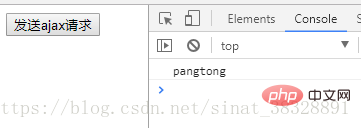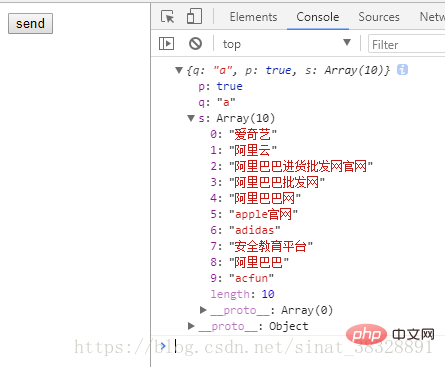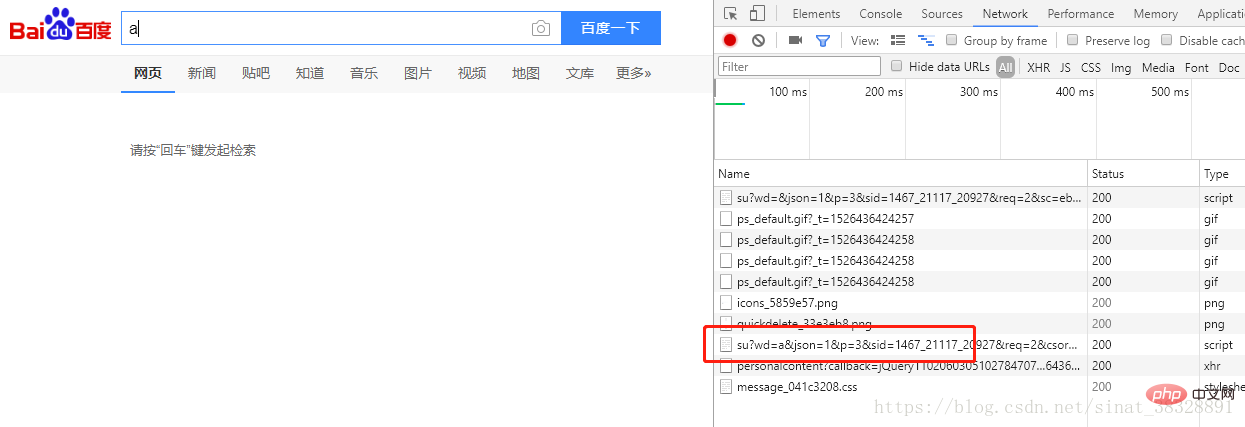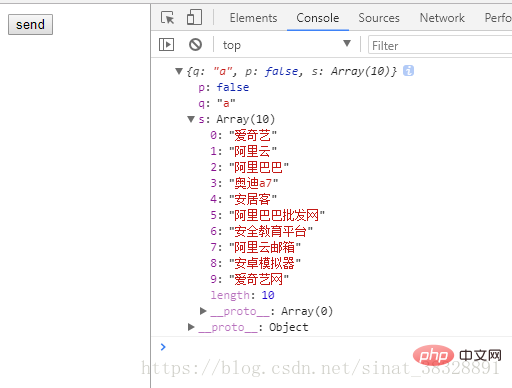How to use ajax in vuejs
Method: 1. Install and introduce axios, and use "axios([option])", "axios.get(url[,...])" and other methods to send requests. 2. Install and introduce vue-resource, and use "this.$http.jsonp(url,[...])" to send the request.

The operating environment of this tutorial: windows7 system, vue2.9.6 version, DELL G3 computer.
Vue itself does not support sending AJAX requests and needs to be implemented using plug-ins such as vue-resource and axios.
axios is a Promise-based HTTP request client used to send requests. It is also officially recommended by vue2.0. At the same time, vue-resource will no longer be updated and maintained.
How vuejs uses ajax
1. Install axios and introduce
1) npm The way: npm install axios -S
2) The bower way: bower install axios
3) The cdn way: <script src="https://unpkg.%20com/axios/dist/axios.min.js%E2%80%9D></script>
2.%20Basic%20usage
1)%20axios(%5Boptions%20%5D)
<!DOCTYPE html>
<html>
<head>
<meta charset="UTF-8">
<title>axios发送ajax请求基本用法</title>
<script src="https://cdn.jsdelivr.net/npm/vue/dist/vue.js"></script>
<script src="https://unpkg.com/axios/dist/axios.min.js"></script>
</head>
<body>
<div id="app">
<button @click="send">发送ajax请求</button>
</div>
<script>
new Vue({
el:"#app",
methods:{
send(){
axios({
method:'get',
url:'user.json'
}).then(function(res){
console.log(res.data.name);
});
}
}
});
</script>
</body>
</html>
2) axios.get(url[,options]);
Parameter passing method:
(1) Pass through url Parameter axios('url?key=value&key1=val2').then();
(2) Pass parameter axios('url',{params:{key:value}}).then(); through params option
3) axios.post(url,data,[options]);
When axios sends data by default, the data format is Request Payload, not the commonly used Form Data Format,
So the parameters must be passed in the form of key-value pairs, not in json form.
Parameter passing method:
(1) Splice it into key-value pairs yourself
axios.post(‘url’,’key=value&key1=value1’).then();
(2) Use transformRequest to convert the request before sending it Data conversion
axios.post('url',data,{
transformRequest:[
function(data){
let params = '';
for(let index in data){
params +=index+'='+data[index]+'&';
}
return params;
}
]
}).then(function(res){
console.log(res.data)
});(3) If you use modular development, you can use the qs module for conversion
axios itself does not support sending cross-domain requests and does not provide For the corresponding API, the author has no plans to add support for sending cross-domain requests in axios.
So we can only use third-party libraries
Cross-domain requests (using vue- resource to send cross-domain requests)
1. Steps to use vue-resource to send cross-domain requests
- Install vue-resource and import it :npm install vue-resource -S
- Basic usage:
Use this.$http.jsonp(url,[ops]) to send a request
2. Basic usage demonstration (360 search)
1) Open 360 search, and then enter the character 'a' and some search options will be automatically prompted, as shown in the figure

2) Copy link
https://sug.so.360.cn/suggest?callback=suggest_so&encodein=utf-8&encodeout=utf-8&format=json&fields=word&word=a
3) Code Demonstration
<!DOCTYPE html>
<html>
<head>
<meta charset="UTF-8">
<title>使用vue-resource发送跨域请求</title>
<!--引入vue、vue-resource文件-->
<script src="vue.min.js"></script>
<script src="vue-resource.min.js"></script>
</head>
<body>
<div id="app">
<button @click="sendJsonp">send</button>
</div>
<script>
var vm = new Vue({
el:"#app",
methods:{
sendJsonp:function(){
this.$http.jsonp('https://sug.so.360.cn/suggest',{
params:{
word:'a'
}
}).then(function(res){
console.log(res.data);
});
}
}
});
</script>
</body>
</html>4) Results

3. Basic example demonstration (Baidu search)
1) The requirements are the same as those of 360 search

2) Copy link
=1526436420943”>https://sp0.baidu.com/5a1Fazu8AA54nxGko9WTAnF6hhy/su?wd=a&json= 1&p=3&sid=1467_21117_20927&req=2&csor=1&cb=jQuery1102060305102784707_1526436420940&=1526436420943
3) Code demonstration (note) – first attempt
If you write according to the above code, the result will be an error
<!DOCTYPE html>
<html>
<head>
<meta charset="UTF-8">
<title>使用vue-resource发送跨域请求</title>
<!--引入vue、vue-resource文件-->
<script src="vue.min.js"></script>
<script src="vue-resource.min.js"></script>
</head>
<body>
<div id="app">
<button @click="sendJsonp">send</button>
</div>
<script>
var vm = new Vue({
el:"#app",
methods:{
sendJsonp:function(){
this.$http.jsonp('https://sp0.baidu.com/5a1Fazu8AA54nxGko9WTAnF6hhy/su',{
params:{
wd:'a'
}
}).then(function(res){
console.log(res.data);
});
}
}
});
</script>
</body>
</html>The result will be an error

Then why is this?
The parameter name of the 360 search jsonp callback before was callback, while the parameter name used by Baidu was cb , so an error will be reported
The modified code is as follows
<!DOCTYPE html>
<html>
<head>
<meta charset="UTF-8">
<title>使用vue-resource发送跨域请求</title>
<!--引入vue、vue-resource文件-->
<script src="vue.min.js"></script>
<script src="vue-resource.min.js"></script>
</head>
<body>
<div id="app">
<button @click="sendJsonp">send</button>
</div>
<script>
var vm = new Vue({
el:"#app",
methods:{
sendJsonp:function(){
this.$http.jsonp('https://sp0.baidu.com/5a1Fazu8AA54nxGko9WTAnF6hhy/su',{
params:{
wd:'a'
},
jsonp:'cb'
}).then(function(res){
console.log(res.data);
});
}
}
});
</script>
</body>
</html>4) Result

##4, Baidu search Case Demonstration
<!DOCTYPE html>
<html>
<head>
<meta charset="UTF-8">
<title>How to use ajax in vuejs列表</title>
<style>
.current{
background-color:#CCCCCC;
}
</style>
<!--引入vue、vue-resource文件-->
<script src="https://cdn.jsdelivr.net/npm/vue/dist/vue.js"></script>
<script src="https://cdn.jsdelivr.net/npm/vue-resource@1.5.0"></script>
</head>
<body>
<script>
window.onload=function() {
new Vue({
el: "#app",
data: {
keyword: '',
myData:[],
now: -1
},
methods: {
getData(e) {
//如果按方向键上、下,则不发请求
if (e.keyCode == 38 || e.keyCode == 40)
return;
this.$http.jsonp(
'https://sp0.baidu.com/5a1Fazu8AA54nxGko9WTAnF6hhy/su', {
params: {
wd: this.keyword
},
jsonp: 'cb'
}).then(function (res) {
console.log(res.data.s);
this.myData = res.data.s;
});
},
changeDown() {
this.now++;
this.keyword = this.myData[this.now];
if (this.now == this.myData.length) {
this.now = -1;
}
},
changeUp() {
this.now--;
this.keyword = this.myData[this.now];
if (this.now == -2) {
this.now = this.myData.length - 1;
}
}
}
});
}
</script>
<div id="app">
<input type="text" v-model="keyword"
@keyup="getData($event)" @keydown.down="changeDown"
@keydown.up.prevent="changeUp"
/>
<ul>
<li v-for="(val,index) in myData" :key="index"
:class="{current:index==now}"
>
{{val}}
</li>
</ul>
</div>
</body>
</html>The above is the detailed content of How to use ajax in vuejs. For more information, please follow other related articles on the PHP Chinese website!

Hot AI Tools

Undresser.AI Undress
AI-powered app for creating realistic nude photos

AI Clothes Remover
Online AI tool for removing clothes from photos.

Undress AI Tool
Undress images for free

Clothoff.io
AI clothes remover

AI Hentai Generator
Generate AI Hentai for free.

Hot Article

Hot Tools

Notepad++7.3.1
Easy-to-use and free code editor

SublimeText3 Chinese version
Chinese version, very easy to use

Zend Studio 13.0.1
Powerful PHP integrated development environment

Dreamweaver CS6
Visual web development tools

SublimeText3 Mac version
God-level code editing software (SublimeText3)

Hot Topics
 How to solve the 403 error encountered by jQuery AJAX request
Feb 20, 2024 am 10:07 AM
How to solve the 403 error encountered by jQuery AJAX request
Feb 20, 2024 am 10:07 AM
Title: Methods and code examples to resolve 403 errors in jQuery AJAX requests. The 403 error refers to a request that the server prohibits access to a resource. This error usually occurs because the request lacks permissions or is rejected by the server. When making jQueryAJAX requests, you sometimes encounter this situation. This article will introduce how to solve this problem and provide code examples. Solution: Check permissions: First ensure that the requested URL address is correct and verify that you have sufficient permissions to access the resource.
 How to solve jQuery AJAX request 403 error
Feb 19, 2024 pm 05:55 PM
How to solve jQuery AJAX request 403 error
Feb 19, 2024 pm 05:55 PM
jQuery is a popular JavaScript library used to simplify client-side development. AJAX is a technology that sends asynchronous requests and interacts with the server without reloading the entire web page. However, when using jQuery to make AJAX requests, you sometimes encounter 403 errors. 403 errors are usually server-denied access errors, possibly due to security policy or permission issues. In this article, we will discuss how to resolve jQueryAJAX request encountering 403 error
 How to get variables from PHP method using Ajax?
Mar 09, 2024 pm 05:36 PM
How to get variables from PHP method using Ajax?
Mar 09, 2024 pm 05:36 PM
Using Ajax to obtain variables from PHP methods is a common scenario in web development. Through Ajax, the page can be dynamically obtained without refreshing the data. In this article, we will introduce how to use Ajax to get variables from PHP methods, and provide specific code examples. First, we need to write a PHP file to handle the Ajax request and return the required variables. Here is sample code for a simple PHP file getData.php:
 How to solve the problem of jQuery AJAX error 403?
Feb 23, 2024 pm 04:27 PM
How to solve the problem of jQuery AJAX error 403?
Feb 23, 2024 pm 04:27 PM
How to solve the problem of jQueryAJAX error 403? When developing web applications, jQuery is often used to send asynchronous requests. However, sometimes you may encounter error code 403 when using jQueryAJAX, indicating that access is forbidden by the server. This is usually caused by server-side security settings, but there are ways to work around it. This article will introduce how to solve the problem of jQueryAJAX error 403 and provide specific code examples. 1. to make
 PHP and Ajax: Building an autocomplete suggestion engine
Jun 02, 2024 pm 08:39 PM
PHP and Ajax: Building an autocomplete suggestion engine
Jun 02, 2024 pm 08:39 PM
Build an autocomplete suggestion engine using PHP and Ajax: Server-side script: handles Ajax requests and returns suggestions (autocomplete.php). Client script: Send Ajax request and display suggestions (autocomplete.js). Practical case: Include script in HTML page and specify search-input element identifier.
 PHP vs. Ajax: Solutions for creating dynamically loaded content
Jun 06, 2024 pm 01:12 PM
PHP vs. Ajax: Solutions for creating dynamically loaded content
Jun 06, 2024 pm 01:12 PM
Ajax (Asynchronous JavaScript and XML) allows adding dynamic content without reloading the page. Using PHP and Ajax, you can dynamically load a product list: HTML creates a page with a container element, and the Ajax request adds the data to that element after loading it. JavaScript uses Ajax to send a request to the server through XMLHttpRequest to obtain product data in JSON format from the server. PHP uses MySQL to query product data from the database and encode it into JSON format. JavaScript parses the JSON data and displays it in the page container. Clicking the button triggers an Ajax request to load the product list.
 What are the ajax versions?
Nov 22, 2023 pm 02:00 PM
What are the ajax versions?
Nov 22, 2023 pm 02:00 PM
Ajax is not a specific version, but a technology that uses a collection of technologies to asynchronously load and update web page content. Ajax does not have a specific version number, but there are some variations or extensions of ajax: 1. jQuery AJAX; 2. Axios; 3. Fetch API; 4. JSONP; 5. XMLHttpRequest Level 2; 6. WebSockets; 7. Server-Sent Events; 8, GraphQL, etc.
 Asynchronous data exchange using Ajax functions
Jan 26, 2024 am 09:41 AM
Asynchronous data exchange using Ajax functions
Jan 26, 2024 am 09:41 AM
How to use Ajax functions to achieve asynchronous data interaction With the development of the Internet and Web technology, data interaction between the front end and the back end has become very important. Traditional data interaction methods, such as page refresh and form submission, can no longer meet user needs. Ajax (Asynchronous JavaScript and XML) has become an important tool for asynchronous data interaction. Ajax enables the web to use JavaScript and the XMLHttpRequest object






